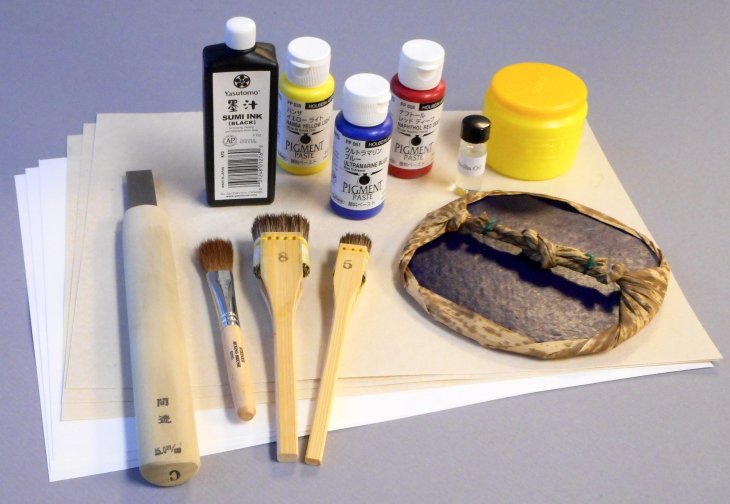

Ukiyo-e – Known as the golden age of Japanese woodblock prints, the design, carving and printing were tasks performed by separate highly skilled artists/craftsmen. So here are a few brief explanations of the different eras of Japanese woodblock prints, how the art has evolved from the 17th century to present day, and how this fertile history has influenced my own creative process and way of thinking. Yet, words and historical context can give the viewer a richer understanding. What’s important is how art makes you feel. The meaning of Japanese woodblock print terms And most significant for artists, are the markedly different handling experiences between the two. With oil, the pigments are much weightier. With watercolor, the colors become luminous through their transparency – the light of the paper shines through the colors. The two processes simply have different aesthetics. In sum, because water and oil based inks have such different looks (and behaviors), the contrast between Japanese and Western processes may be compared to the distinction between watercolor and oil painting. Mostly referred to as ‘woodcut’, attention in the West is typically focused on the drawing-like cut lines in the wood – versus the flat, shadowless shapes of layered colors in the Japanese approach. In Europe, this medium was developed to an extraordinary degree during the Renaissance (notably, German artist Albrecht Dürer). The image from the carved block may be transferred to the paper by pressures as varied as rubbing the back of the paper with a wooden spoon to using a mechanical press. We will be increasing the supplies we stock from Japan – hopefully they will start appearing on the site in the next few weeks.Unlike Japanese techniques, Western methods utilize viscose, tacky inks (historically oil based) applied to blocks with rubber-like rollers, called brayers. One of my favourite shops was Pigment – can you guess what it sells? Unbelievably beautiful rows and rows of pigments in every shade you could imagine. Summer Deer, Goat and Horse tend to be used for different purposes for Mokuhanga. Brushes are very valued in Japan and are made from a few different animals I spent a lot of time looking for new suppliers and going to beautiful art shops. He has two pieces in this years Summer Exhibition at the Royal College of Art which runs till the 20th August – so if you are in London it is a must see. His latest work is mostly printed using CMYK. He used the traditional artform of Mokuhanga in such a modern way. His prints are so alive that you felt that they were three dimensional. He works using photography but cutting the images all by hand in the traditional way. I loved seeing the work of Katsutoshi Yuasa – his website can be viewed here


Not one of my favourites!Īfter the course finished I had a few days meeting with suppliers and a couple of Mokuhanga artists. One other thing that I learnt whilst in Japan is that Kit Kat can come in many different flavours – this one is Matcha. Working out colours in my sketchbook and yet again I was using too much Nori. Using three colours of paint and the colour of the paper to create six different colours. Or the elements will not register successfully.įor my second print I wanted to try something a little more complicated and use the layering of the blocks to create extra colours. These have to be in exactly the same place for each layer You register each print using Kento marks (registration marks) that you carve into the blocks. Too much Nori paste which caused me lots of problems. One word he said more than any other sounded like ‘squashy’ which means less! – I always seemed to be using The cutting is the bit that seems to take the most time but the printing is the bit that is the hardest to get right. You apply the paints to the ply with printing brushes. Mokuhanga printmaking uses waterĬolour or gouache paints and Nori (rice paste). I wanted a bit of Bokashi printing (graduation of colour).
#Moku hanga carving blocks full#
I have been lucky enough to attend a couple of Laura Boswell’s courses (her courses with us are full for 2017 but her 2018 courses will be on the website soon!) I have neverīeen anywhere like Tokyo before so it was an experience on lots of different levels. I (Shirley) have been on a trip to Tokyo to attend a five day Mokuhanga course (Japanese Woodblock) and to meet with a few of our suppliers.


 0 kommentar(er)
0 kommentar(er)
